The Story of a Wall
The Opening of the Green Line, Nicosia 2008
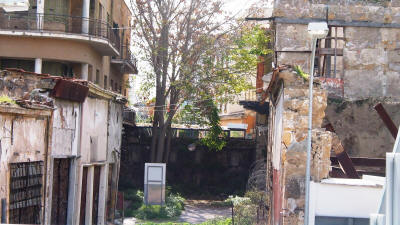 |
| No Man's Land to be Made Safe |
It was agreed at the meeting last Friday between Turkish Cypriot President, Mehmet Ali Talat, and Greek Cypriot President, Demetris Christofias, to open the Lokmaci Barricade (on Ledra Street) which has been the main item on agendas for both the Turkish and Greek Cypriots over the last three years.
The Greek Cypriot's previous stance of being against the opening unless the footbridge, flags, symbols and signs of borders were removed from the area, together with the presence of the military which prevented the Lokmaci barricade being opened, will now with the opening of this border mostly benefit the local traders of the area.
 |
| The Now Demolished Bridge |
A symbol of conflict
The Lokmaci Barricade, which will be open to pedestrian traffic
between the Turkish Cypriot and Greek Cypriot sides, is seen as a
symbol of conflict and division.
It is seen as the symbol created by the Greek Cypriot EOKA in their struggle for Enosis (the dream of unifying Cyprus with Greece) which started in 1956. The first division in Cyprus was at Lokmaci.
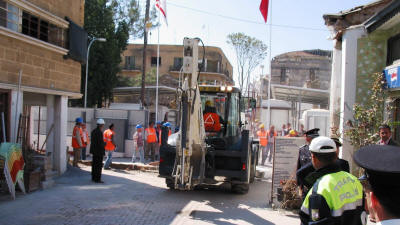 |
| 2nd April 2008. The Barrier Being Removed |
The Lokmaci (Ledra Street) was barricaded in 1963 as a result of the Greek Cypriot Enosis campaign. Both sides later erected walls on this part off the border following the military coup against Makarios in 1974
Lokmaci is looked upon as a symbol of those who strived for division and for Enosis. The barricade was created to protect the Turkish Cypriots from the Greek Cypriots who had forced them out of the government at gunpoint in 1963. It has been recorded in history as the first barricade to go up in Cyprus and therefore is seen as the symbol of division on the island created by Enosis.
The barricade separated Lokmaci from Ledra Street which was one of the most important shopping centres of that period. Lokmaci remained on the Turkish side with Ledra Street remaining on the Greek side. Just like Cyprus, the shopping areas, which both the Turks and Greeks frequented, was split in two.
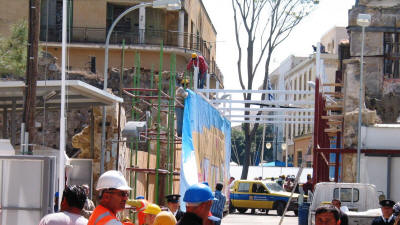 |
| Buildings inside No Man's Land Being Made Safe |
Demolishing the Lokmaci Wall
Talks on removing the Lokmaci Wall began in late 2005 when the
opening of the border was a continuing subject of debate in Cyprus.
The Turkish Cypriot administration started to work towards the
opening of the border in November and the wall was demolished on the
evening of 24th November 2005. A footbridge was erected so as to
avoid the pedestrians at the crossing clashing with he military
guard patrols. Work on the footbridge began on the12th December and
was completed on the 24th December 2005. The High Commissioner for
Turkey, based in Nicosia, funded half of the costs of building the
bridge which totalled just under 1 million TL.
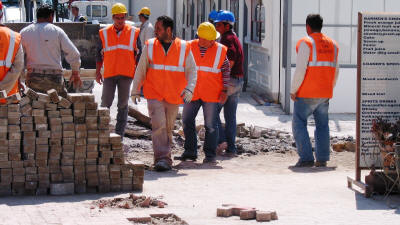 |
| Paving Being Laid in Readiness for the Opening |
The Greek Cypriot side supported the opening of the border at the onset but withdrew their support, saying that the building works had infringed on to the buffer zone. They complained to the United Nations about Turkish Cypriots efforts towards opening of the border.
The spokesperson for the United Nations Forces in Cyprus (UNFICYP) declared that no infringement into the buffer zone had been made, but, in a written statement dated 8th December 2005, UNFICYP declared that they would not support the opening of the Lokmaci border (Ledra Street) unless the two sides were in agreement, and asked the Turkish Cypriot side to stop the works. The Lokmaci border which is included n the Green Line Regulation could not be opened in 2005.
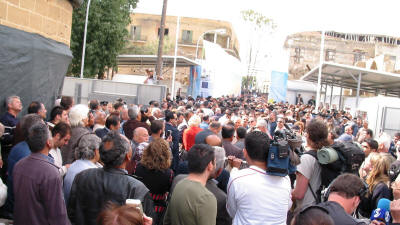 |
| 3rd April 2008. The Crowds Wait in Anticipation |
The result of arguments against the footbridge.
Turkish Cypriot President, Mehmet Ali Talat made the decision to
remove the footbridge because the Greek Cypriot side were using it
as an excuse not to open the border.
Presidential Spokesperson Hasan Ercakica announced on 28th December 2006 that a decision had been made to remove the footbridge which was seen as an obstacle by the Greek Cypriots. The removal of the bridge would enable the two sides to begin talks towards a comprehensive solution in the first quarter of 2007 and to help the two sides to develop working relationships.
The United Nations were informed by letter of the Turkish Cypriot side's decision. Both the US Ambassador and the British High Commissioner based in the Greek Cypriot South said that they were pleased with this decision. The footbridge on the Turkish Cypriot side of the Lokmaci border was removed on 9th January 2007.
 |
| A Feeling of Celebration |
The Greek Cypriots persisted.
The removal of the footbridge was a positive step, the Greek Cypriot
side said, but it was not enough and that all of the obstacles had
not yet been removed. As they were, from the beginning not really
for the opening of the border, the Greek Cypriots kept pushing for
the border to be opened but only under certain conditions. They
wanted flags and the military presence removed from the area as well
as all symbols or recognition of borders in the area.
Suddenly one night it was demolished.
The Greek Cypriot side, who used many excuses for not opening the
barricade, with a sudden decision demolished the wall on their side
late in the evening on 8th March 2007, whilst Turkish Cypriot
President Mehmet Ali Talat was visiting Azerbaijan and Turkish
Cypriot Prime Minister Ferdi Sabit Soyer was in Germany. The
breaking down of the wall, seen by the Greek Cypriots as "the wall
which split Nicosia in two", was still not enough for the pedestrian
crossings to begin. The Greek Cypriot administration persisted with
other conditions.
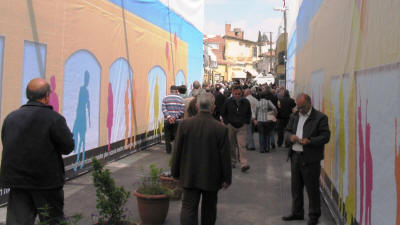 |
| The Fully Open Crossing |
The Traders will benefit.
The opening of the Lokmaci border for crossings between the North
and South of Cyprus will mostly benefit the traders in the area.
When Greek Cypriots cross to the Turkish Cypriot side they mostly shop in the Arasta shopping area. The area traders say that the opening of the Lokmaci border will bring easier access and make the journey for the shoppers much shorter. They believe that this will bring more customers and life to the area. The other most important point regarding The opening of this border is that the capital city of Nicosia on both sides will again be joined together at the very place of Cyprus's first separation and border.
It is expected that, following necessary technical preparations, the opening of the Lokmaci border will take place on either the 31st march or the 1st April during the planned visit to the island by Lyn Pascoe, Political Affairs Assistant to the United nations Secretary-General.
Text Cyprus Observer, 28th March 2008. Photos www.whatson-northcyprus.com